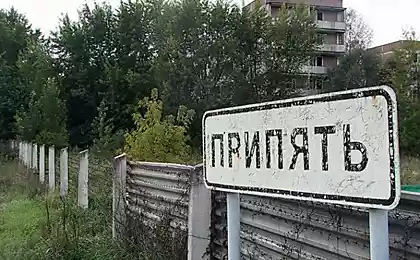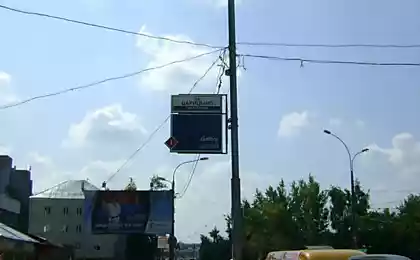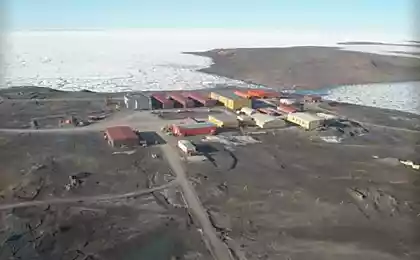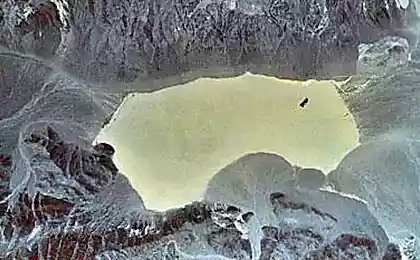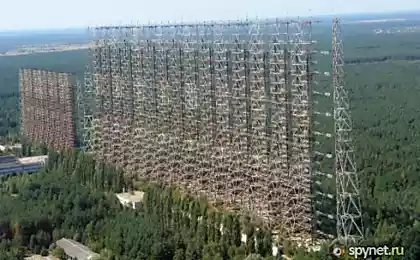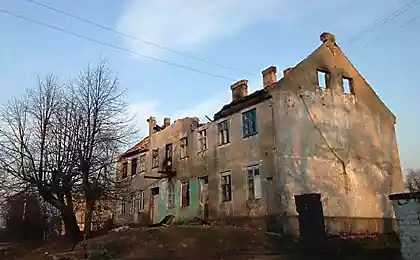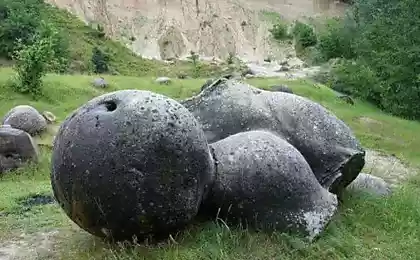1558
Oil Stones
Oil Rocks - urban-type settlement in the Azerbaijan sector of the Caspian Sea, which is also unique offshore field. He himself stands on metal stilts that have been built already in 1949. It was then that began to extract oil from the seabed in the area. He even managed to get into the Guinness Book of Records lists as the oldest offshore oil platforms. Under the cut, you can learn the history of this unique city.

Production of black, bad-smelling, but the flammable liquid primitive artisanal began in Azerbaijan in the Middle Ages. Centre crafts became the Apsheron Peninsula, the largest city which was and remains the capital of Azerbaijan, Baku. The value of the resource, called "black gold", mankind has realized much later - the real oil boom broke out around Baku in the second half of the XIX century, decorated outskirts of the city with hundreds of towers.

At the beginning of the next XX century Baku has become the oil capital of the Russian Empire, it was mined here for nearly 90% of its oil and about half of the country - all over the world. "Black gold" brought to Baku industrialists, among them the Nobel and Rothschild families, millions of rubles.
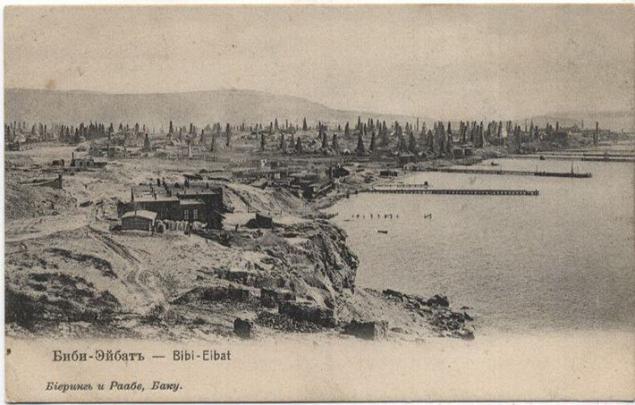
The Soviet government, of course, oil is selected from the private sector. At the same time easy to develop the field in Apsheron gradually began to dwindle, and the state faced the task of finding new sources of raw materials, has acquired a strategic character. Shortly after the end of World War II was the principal decision - to go after the oil into the sea.
In the Caspian Sea about a hundred kilometers from the coast of the Absheron Peninsula there a place nicknamed fishermen Black Stones. It was a ridge barely protruding above the surface of the sea cliffs that had a distinctive black and gray. This water with oily stains hinted the release of oil somewhere nearby. In November 1948 Black stones landed Geological Prospecting Troopers, who personally led Nikolai Baibakov, oil minister and future long-term chairman of Gosplan. Conclusion Commission representative was clear and optimistic - the oil on the black stone there, and a lot of it.
It looked like the next city in the early days of its existence.

The sea depth in the area was only 5-20 meters, so management association "Azneft" has decided to build a base oil directly into the open sea. Had rocky islets for this was still not enough, therefore, served as a springboard old, ready to write off the ship "Chvanov." Waterlogged boat was at the same time and the first residence of the drillers, to place in his cabin. A year after the beginning of the development of the deposit first well earned km depth, then immediately renamed Black stones in the oil.
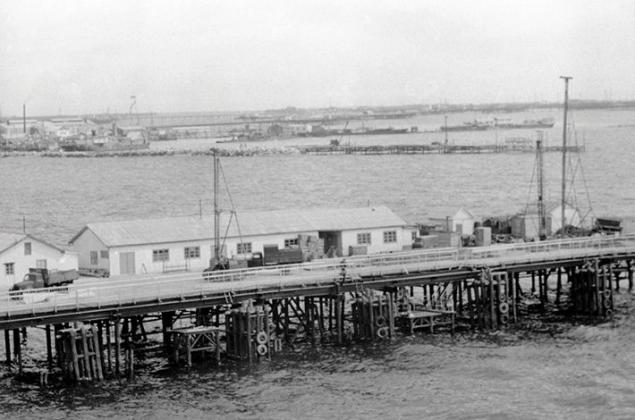
Over the next six months, the pioneers "Chvanova" towed and sunk six old, served their ships. Thus it was formed "Island of seven ships", the heart of the future of the village. Vessel interconnected with a number of islands of the available metal racks mounted on wooden piles. Design has acquired quickly and the first time until houses.

Soon drillers were able to move in a relatively comfortable housing - for them at the Oil Rocks built a 16-storey wooden houses. In addition, there were built two power stations, dining room, sauna, medical center, library - a good infrastructure for the village is surrounded by the sea.
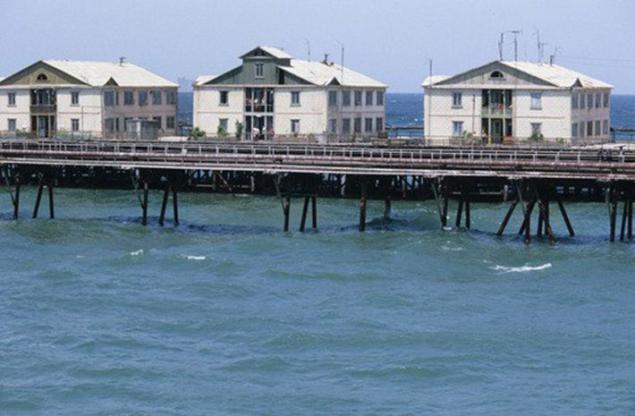
She grew up and the area of land reclaimed from the water. On special ships were brought here more than half a million cubic meters of sand and rock. The shallow depth of the sea allowed to combine natural and artificial islands into a unified whole.
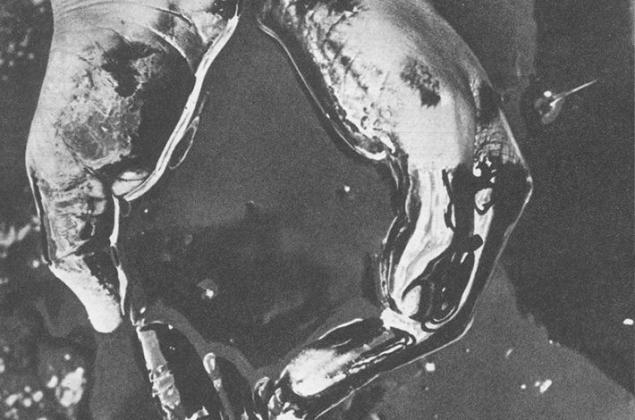
In parallel with the increase in the number of wells to actively build and interconnect the racks. It was an amazing sight - dozens, hundreds of permanent buildings, oil rigs, oil wells, coupled kilometers of bridges, which briskly drove cars and trucks. Around the same only the Caspian Sea, to the nearest land hundreds of kilometers by boat or helicopter.
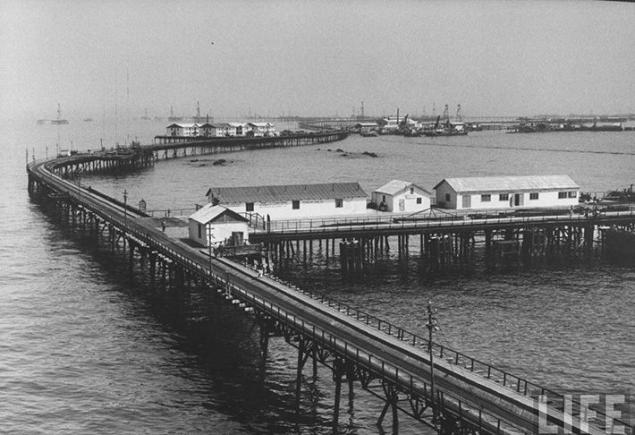


The center of the camp with built for drillers and staff two-story houses.

This color image of the 1960s clearly visible even partially protruding above the water surface black rocky islets. Far away in the center - "Island of seven ships».
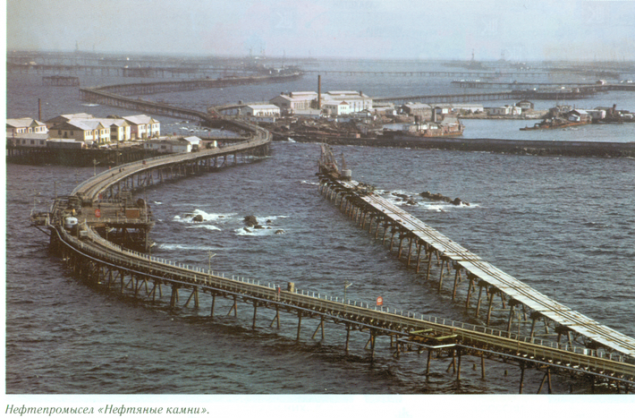
Since the end of 1940 at the Oil Rocks were drilled about 2,000 wells, which gave 60% of the Soviet marine oil. Initially, it was delivered by tankers to land, but in 1981 was handed a 78-kilometer underwater pipeline would eliminate the use of ships, whose operation in shallow water and many in this area of the sea cliffs is a risk.

Even more dangerous is the frequent storms on the Caspian Sea. In the early years of "neftekamennogo" field all waterworks were built with wooden piles, raises them to a height of 6, 5 meters. How quickly proved nature, it was not enough. September 15, 1956 broke a catastrophic storm that resulted in casualties.
"In the morning blowing north wind, its speed increased rapidly and after 2 hours reached 35 m / s with gusts up to 40 m / s. On land the wind like power rips roofs, uproots trees, destroying power lines and sea wave disperses the powerful. The strength of the storms reached 12 on the Beaufort scale. The wind was blowing continuously for more than two days. The giant waves that hit the oil field, destroyed about 4 kilometers offshore platforms, eight priestakadnyh areas, six of which have given oil in continuous operation. Victims and naval base. But the most tragic result of an unprecedented storm - the death of 22 oil workers, "- wrote the magazine" Science and Life ».
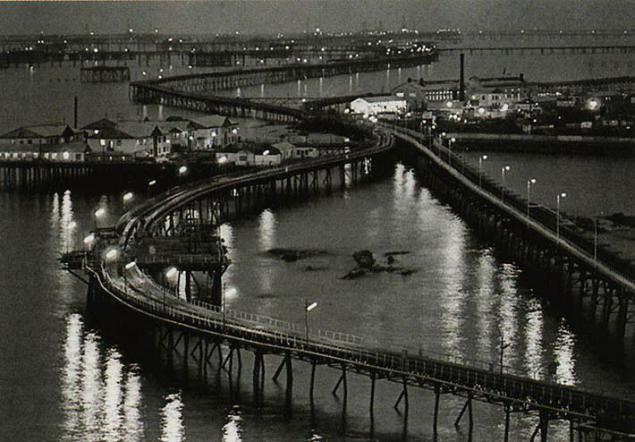
Designers and builders have learned a sad lesson. The height of the floor construction on buildings was raised to the level of 11, 6 meters above the calm water, and wood piles have become massively replace metal.

Permanent population in the Oil Rocks were not. Drillers working in shifts, and initially brought them to work the ship. At first, the ships go by sea terminal on the island of Artyom connected with the dam of the Apsheron Peninsula (even allowed to train from Baku!), It was later established by maritime passenger transport station of the Azerbaijani capital. However, the transition by sea was uncomfortable in bad weather stretched for many hours, and during storms and stopped altogether. The situation was corrected in 1960, when the Oil Rocks visited Nikita Khrushchev. Emotional Soviet leader so impressed with the village, which he ordered to organize a special helicopter detachment for transportation shifts on watch back and forth.
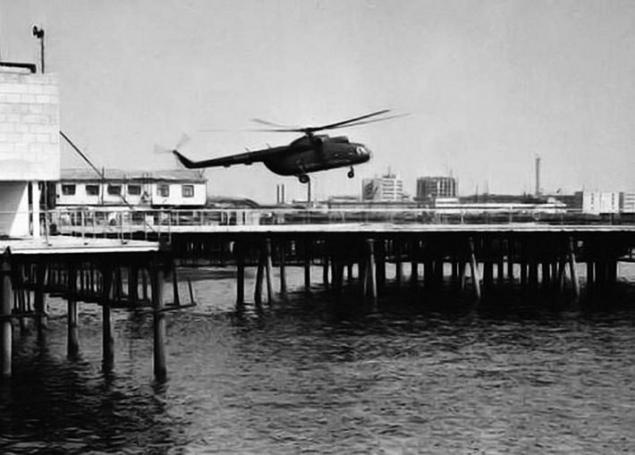
Helicopters often used for the delivery of oil to the well. The number of fixed platforms so increased (now about 200), and the mileage ramps up so that the use of road transport in some cases it was simply ineffective. Currently, the total length of the "streets" of this unusual village reached 350 kilometers.
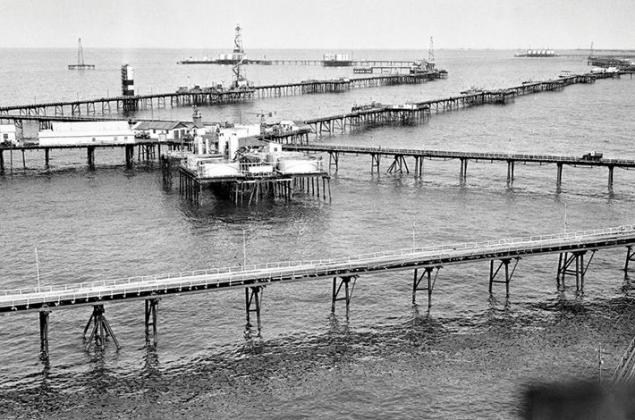
The roads here are, of course, SSB, vehicles are leaving the counter or on the platforms, or through regularly organized special "pockets».
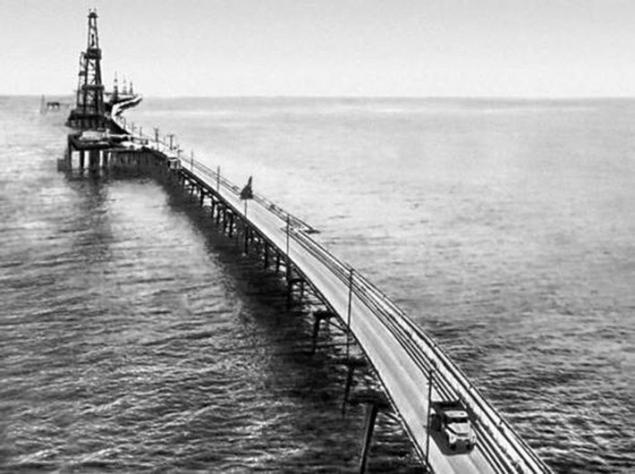
In Soviet times, the Oil Rocks simultaneously employed about 5000 people. Despite the adoption of the format shift here hostel dwellers are constantly changing, life of the people here was equipped well. Besides baths, dining room and infirmary, eventually there came a bakery, a movie theater, even the lemonade shop, whose products are exported to the "mainland." Drillers regularly entertained and artists arriving from Baku. All this allows us to live and work with some comfort, though, of course, not without some restrictions. For example, the Oil Rocks is strictly prohibited alcohol and, of course, cigarettes.

The picture in 1957 is visible even improvised "promenade" with growing potted plants, benches and walk in his spare time workers.

However, during that same visit, Khrushchev's 1960 workers complained to the head of the country's living conditions in the Oil Rocks. The wooden two-storey houses are, in fact, were the usual cheap barracks, which were built in large quantities in the Soviet Union after the war. Nikita immediately ordered to provide modern housing for drillers. It was decided to replace dvuhetazhki 5- and 9-storey dormitory. Site preparation for the construction of stretches for almost a decade. In the central part of the village, "Island of seven ships", was erected a huge concrete platform that has become the foundation for new, high-rise buildings already. Such construction were not afraid of any storms.

A total of 1970 here built three five-storey and two nine-storey dormitory. New Oil Rocks bird's-eye view.

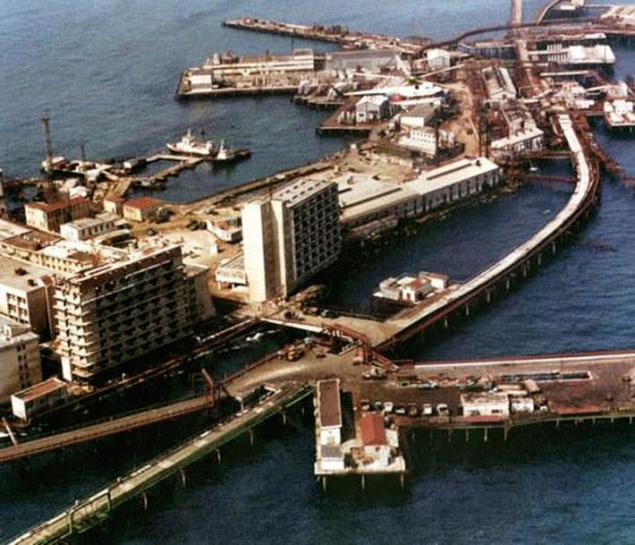
High-rise buildings seem to grow out of the sea.
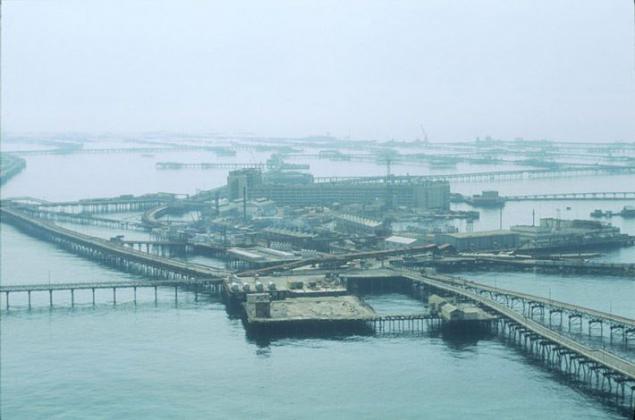
Having survived the difficult 1990s, the 2000s oil stones have entered a new period of prosperity. Grown rich on oil exports, Azerbaijan has revolutionized the central part of the village. Upgrades have undergone all the hostels, a number of new modern buildings. So the village looks now.
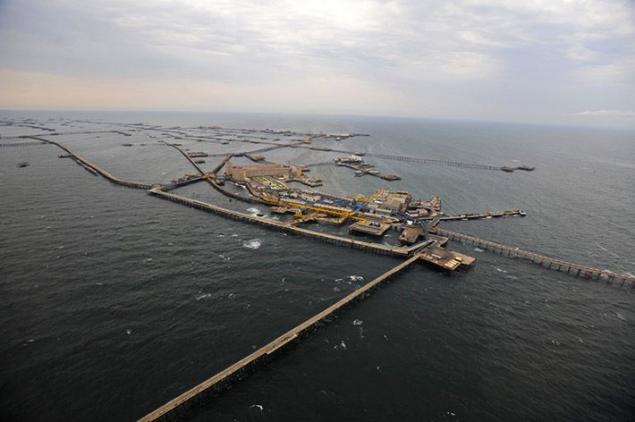
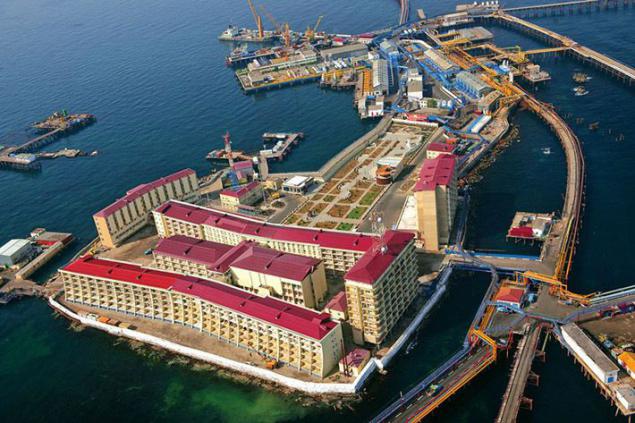
The complex of dormitories is now more like a sanatorium on some all-Union health resort.

Boarding oil workers and support staff are divided into male and female. Women, however, for objective reasons, there is only one, and combined with the dining room of village. In the foreground is the very first borehole of 1949 preserved as a monument.
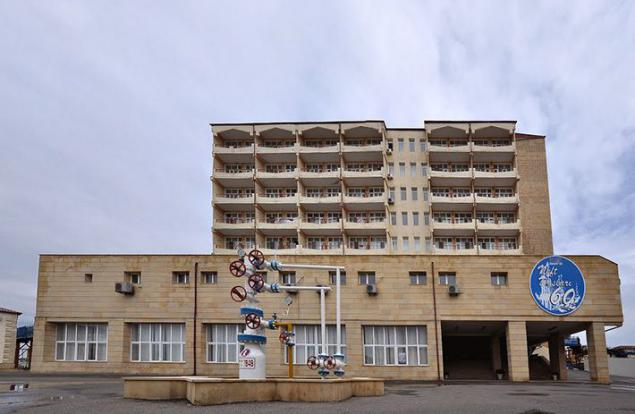
In the dining room of the village.

Save and relic work of monumental and decorative art - colorful mosaic depicting joyous life in Soviet Azerbaijan.
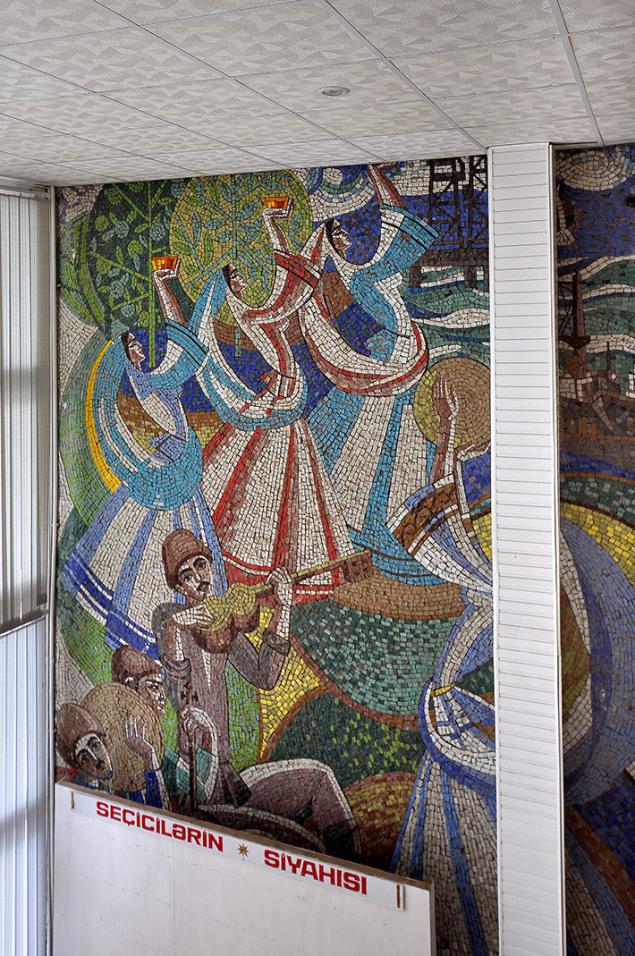
Men occupy the second nine-and somewhat lengthy, often curved five-storey buildings.

But once, more than 60 years ago, it all began with just such temporary housing.
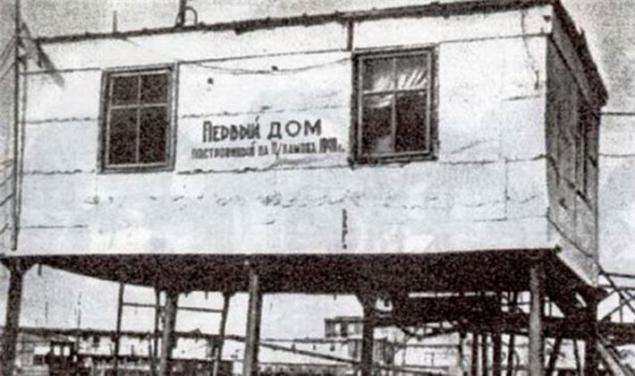
Now a fragment of the very first house on the high seas as a monument.
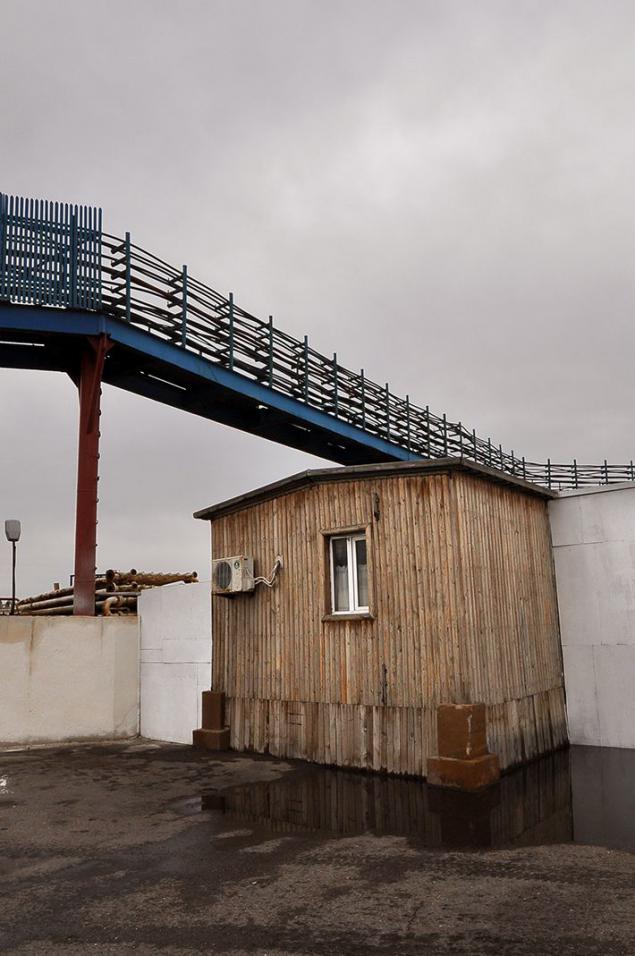
The living area is divided and a small park. So it looked in the 1980s.
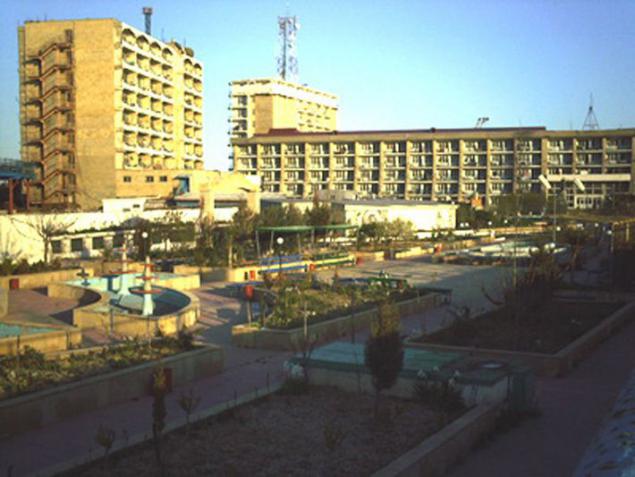
In the second half of the 2000s, the park with the rest of the center of the oil stones has been reconstructed.
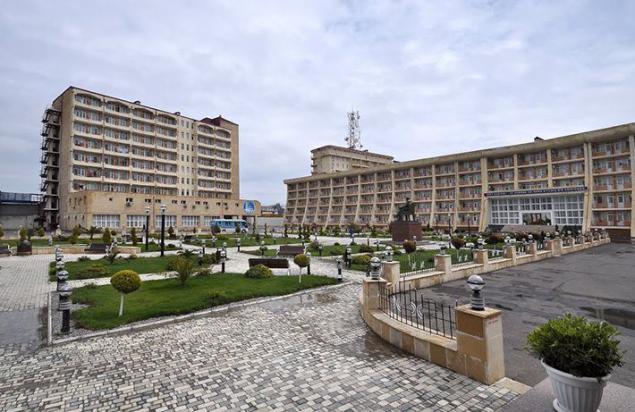
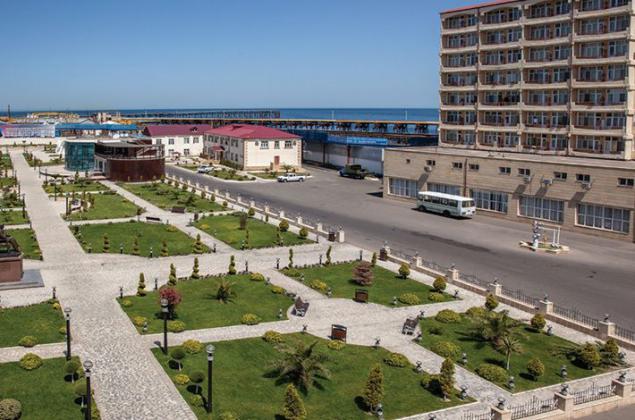
In addition to the overall improvement of its decorated a number of memorials, for example after local drillers Petroleum.
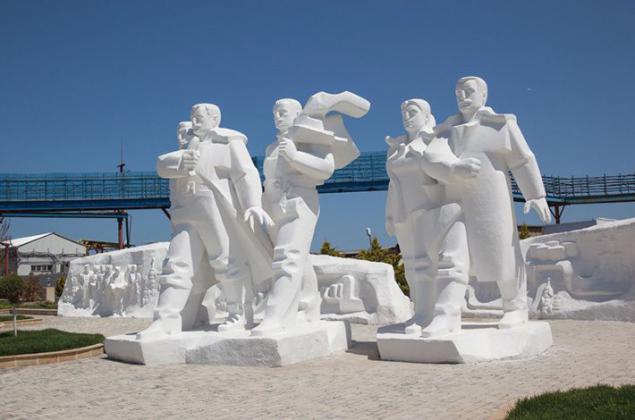
Or the victims of the catastrophic storms in 1956.
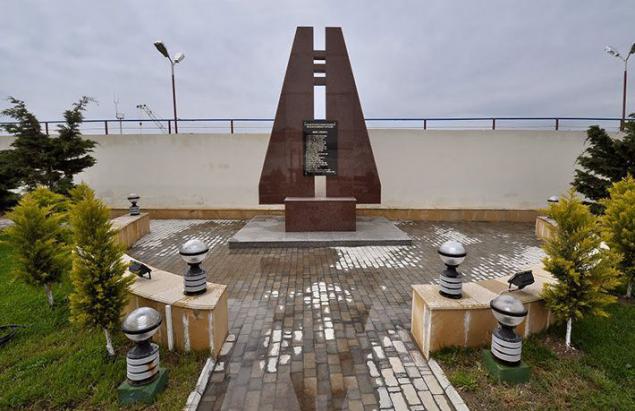
And of course, there were a monument to the late President of the country (and father of the current president) Heydar Aliyev.
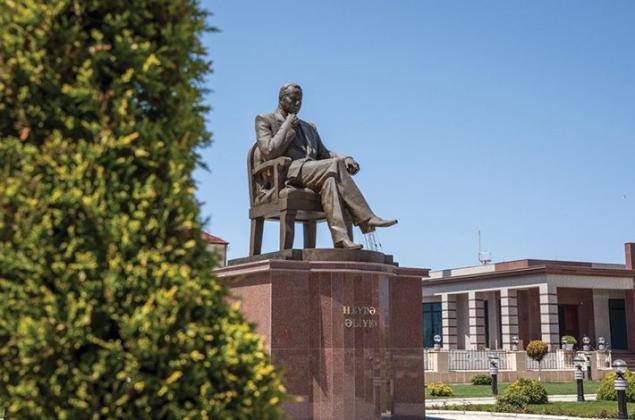
As in many towns of Azerbaijan, the Oil Rocks was built even a single museum Aliyev's father.

Another new building of the village was the "Tea House". In the context of the "dry law" has to workers (though probably with pleasure) in his spare time to settle for this cafe. Watch now standard in Oil Rocks last week with a possible extension for another one in case of stormy weather.

Football field for those who after a 10-12-hour shifts left hand at the sport. In the 1990s, there existed even a mosque, later closed.

"Neftekamennaya" Hospital. The village even has its own coach "ambulance" - we must not forget that the distance here can amount to tens of kilometers.
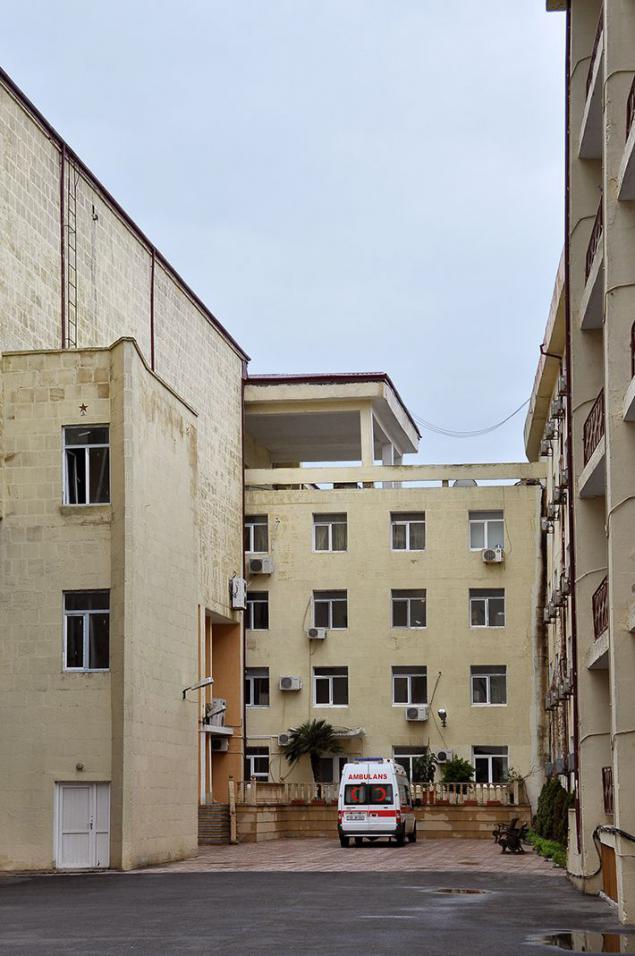
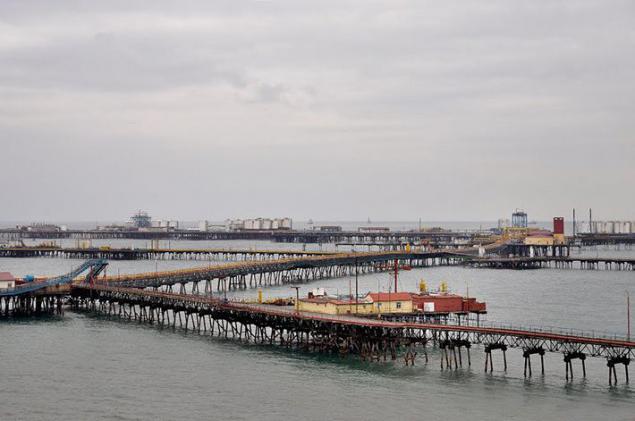
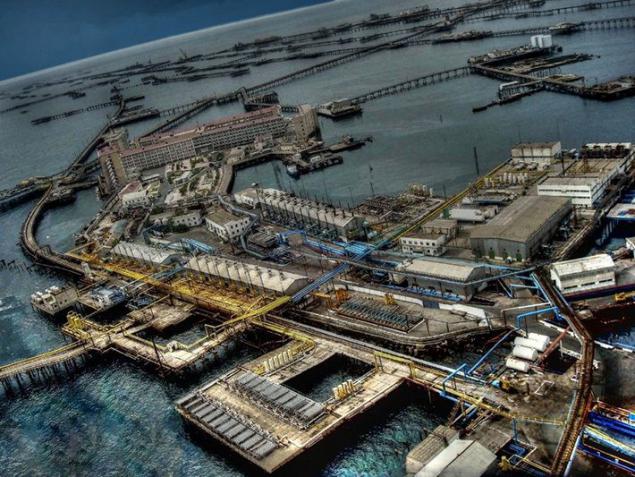
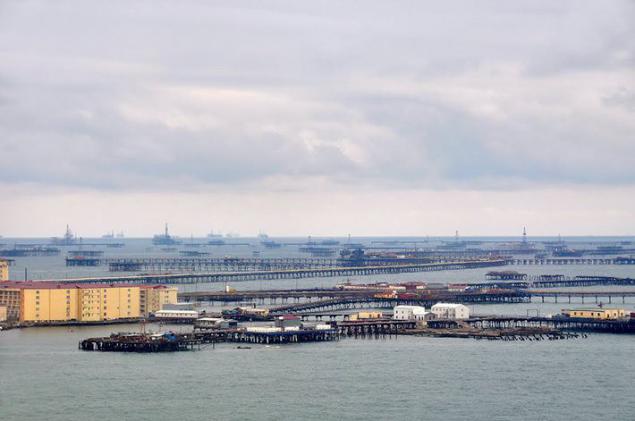
In 64 years of existence of the Oil stones it is produced more than 160 million tons of oil and 13 billion cubic meters of associated gas. Until now, with about 400 holes, each of which provides an average of up to 5 tonnes per day. Thus, according to geologists, there extract about 21 million tons of resources, which has become the blood of modern human civilization.
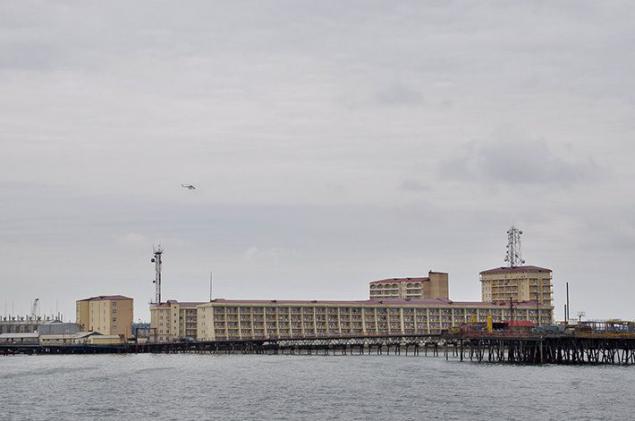

What future for oil stones, when the "black gold" here comes to an end? Perhaps the village will continue to grow through extensive, will be built next to the new platforms kilometers platforms and derricks. Perhaps someday people he does leave, as happened with the miners Japanese island Hasim (read the story about it tomorrow), but to create generations of oilmen and builders of infrastructure, most likely it will long remain a monument to the power of the human spirit, capable in all conditions put the nature of his service.

Source: realt.onliner.by

Production of black, bad-smelling, but the flammable liquid primitive artisanal began in Azerbaijan in the Middle Ages. Centre crafts became the Apsheron Peninsula, the largest city which was and remains the capital of Azerbaijan, Baku. The value of the resource, called "black gold", mankind has realized much later - the real oil boom broke out around Baku in the second half of the XIX century, decorated outskirts of the city with hundreds of towers.

At the beginning of the next XX century Baku has become the oil capital of the Russian Empire, it was mined here for nearly 90% of its oil and about half of the country - all over the world. "Black gold" brought to Baku industrialists, among them the Nobel and Rothschild families, millions of rubles.

The Soviet government, of course, oil is selected from the private sector. At the same time easy to develop the field in Apsheron gradually began to dwindle, and the state faced the task of finding new sources of raw materials, has acquired a strategic character. Shortly after the end of World War II was the principal decision - to go after the oil into the sea.
In the Caspian Sea about a hundred kilometers from the coast of the Absheron Peninsula there a place nicknamed fishermen Black Stones. It was a ridge barely protruding above the surface of the sea cliffs that had a distinctive black and gray. This water with oily stains hinted the release of oil somewhere nearby. In November 1948 Black stones landed Geological Prospecting Troopers, who personally led Nikolai Baibakov, oil minister and future long-term chairman of Gosplan. Conclusion Commission representative was clear and optimistic - the oil on the black stone there, and a lot of it.
It looked like the next city in the early days of its existence.

The sea depth in the area was only 5-20 meters, so management association "Azneft" has decided to build a base oil directly into the open sea. Had rocky islets for this was still not enough, therefore, served as a springboard old, ready to write off the ship "Chvanov." Waterlogged boat was at the same time and the first residence of the drillers, to place in his cabin. A year after the beginning of the development of the deposit first well earned km depth, then immediately renamed Black stones in the oil.

Over the next six months, the pioneers "Chvanova" towed and sunk six old, served their ships. Thus it was formed "Island of seven ships", the heart of the future of the village. Vessel interconnected with a number of islands of the available metal racks mounted on wooden piles. Design has acquired quickly and the first time until houses.

Soon drillers were able to move in a relatively comfortable housing - for them at the Oil Rocks built a 16-storey wooden houses. In addition, there were built two power stations, dining room, sauna, medical center, library - a good infrastructure for the village is surrounded by the sea.

She grew up and the area of land reclaimed from the water. On special ships were brought here more than half a million cubic meters of sand and rock. The shallow depth of the sea allowed to combine natural and artificial islands into a unified whole.

In parallel with the increase in the number of wells to actively build and interconnect the racks. It was an amazing sight - dozens, hundreds of permanent buildings, oil rigs, oil wells, coupled kilometers of bridges, which briskly drove cars and trucks. Around the same only the Caspian Sea, to the nearest land hundreds of kilometers by boat or helicopter.



The center of the camp with built for drillers and staff two-story houses.

This color image of the 1960s clearly visible even partially protruding above the water surface black rocky islets. Far away in the center - "Island of seven ships».

Since the end of 1940 at the Oil Rocks were drilled about 2,000 wells, which gave 60% of the Soviet marine oil. Initially, it was delivered by tankers to land, but in 1981 was handed a 78-kilometer underwater pipeline would eliminate the use of ships, whose operation in shallow water and many in this area of the sea cliffs is a risk.

Even more dangerous is the frequent storms on the Caspian Sea. In the early years of "neftekamennogo" field all waterworks were built with wooden piles, raises them to a height of 6, 5 meters. How quickly proved nature, it was not enough. September 15, 1956 broke a catastrophic storm that resulted in casualties.
"In the morning blowing north wind, its speed increased rapidly and after 2 hours reached 35 m / s with gusts up to 40 m / s. On land the wind like power rips roofs, uproots trees, destroying power lines and sea wave disperses the powerful. The strength of the storms reached 12 on the Beaufort scale. The wind was blowing continuously for more than two days. The giant waves that hit the oil field, destroyed about 4 kilometers offshore platforms, eight priestakadnyh areas, six of which have given oil in continuous operation. Victims and naval base. But the most tragic result of an unprecedented storm - the death of 22 oil workers, "- wrote the magazine" Science and Life ».

Designers and builders have learned a sad lesson. The height of the floor construction on buildings was raised to the level of 11, 6 meters above the calm water, and wood piles have become massively replace metal.

Permanent population in the Oil Rocks were not. Drillers working in shifts, and initially brought them to work the ship. At first, the ships go by sea terminal on the island of Artyom connected with the dam of the Apsheron Peninsula (even allowed to train from Baku!), It was later established by maritime passenger transport station of the Azerbaijani capital. However, the transition by sea was uncomfortable in bad weather stretched for many hours, and during storms and stopped altogether. The situation was corrected in 1960, when the Oil Rocks visited Nikita Khrushchev. Emotional Soviet leader so impressed with the village, which he ordered to organize a special helicopter detachment for transportation shifts on watch back and forth.

Helicopters often used for the delivery of oil to the well. The number of fixed platforms so increased (now about 200), and the mileage ramps up so that the use of road transport in some cases it was simply ineffective. Currently, the total length of the "streets" of this unusual village reached 350 kilometers.

The roads here are, of course, SSB, vehicles are leaving the counter or on the platforms, or through regularly organized special "pockets».

In Soviet times, the Oil Rocks simultaneously employed about 5000 people. Despite the adoption of the format shift here hostel dwellers are constantly changing, life of the people here was equipped well. Besides baths, dining room and infirmary, eventually there came a bakery, a movie theater, even the lemonade shop, whose products are exported to the "mainland." Drillers regularly entertained and artists arriving from Baku. All this allows us to live and work with some comfort, though, of course, not without some restrictions. For example, the Oil Rocks is strictly prohibited alcohol and, of course, cigarettes.

The picture in 1957 is visible even improvised "promenade" with growing potted plants, benches and walk in his spare time workers.

However, during that same visit, Khrushchev's 1960 workers complained to the head of the country's living conditions in the Oil Rocks. The wooden two-storey houses are, in fact, were the usual cheap barracks, which were built in large quantities in the Soviet Union after the war. Nikita immediately ordered to provide modern housing for drillers. It was decided to replace dvuhetazhki 5- and 9-storey dormitory. Site preparation for the construction of stretches for almost a decade. In the central part of the village, "Island of seven ships", was erected a huge concrete platform that has become the foundation for new, high-rise buildings already. Such construction were not afraid of any storms.

A total of 1970 here built three five-storey and two nine-storey dormitory. New Oil Rocks bird's-eye view.


High-rise buildings seem to grow out of the sea.

Having survived the difficult 1990s, the 2000s oil stones have entered a new period of prosperity. Grown rich on oil exports, Azerbaijan has revolutionized the central part of the village. Upgrades have undergone all the hostels, a number of new modern buildings. So the village looks now.


The complex of dormitories is now more like a sanatorium on some all-Union health resort.

Boarding oil workers and support staff are divided into male and female. Women, however, for objective reasons, there is only one, and combined with the dining room of village. In the foreground is the very first borehole of 1949 preserved as a monument.

In the dining room of the village.

Save and relic work of monumental and decorative art - colorful mosaic depicting joyous life in Soviet Azerbaijan.

Men occupy the second nine-and somewhat lengthy, often curved five-storey buildings.

But once, more than 60 years ago, it all began with just such temporary housing.

Now a fragment of the very first house on the high seas as a monument.

The living area is divided and a small park. So it looked in the 1980s.

In the second half of the 2000s, the park with the rest of the center of the oil stones has been reconstructed.


In addition to the overall improvement of its decorated a number of memorials, for example after local drillers Petroleum.

Or the victims of the catastrophic storms in 1956.

And of course, there were a monument to the late President of the country (and father of the current president) Heydar Aliyev.

As in many towns of Azerbaijan, the Oil Rocks was built even a single museum Aliyev's father.

Another new building of the village was the "Tea House". In the context of the "dry law" has to workers (though probably with pleasure) in his spare time to settle for this cafe. Watch now standard in Oil Rocks last week with a possible extension for another one in case of stormy weather.

Football field for those who after a 10-12-hour shifts left hand at the sport. In the 1990s, there existed even a mosque, later closed.

"Neftekamennaya" Hospital. The village even has its own coach "ambulance" - we must not forget that the distance here can amount to tens of kilometers.




In 64 years of existence of the Oil stones it is produced more than 160 million tons of oil and 13 billion cubic meters of associated gas. Until now, with about 400 holes, each of which provides an average of up to 5 tonnes per day. Thus, according to geologists, there extract about 21 million tons of resources, which has become the blood of modern human civilization.


What future for oil stones, when the "black gold" here comes to an end? Perhaps the village will continue to grow through extensive, will be built next to the new platforms kilometers platforms and derricks. Perhaps someday people he does leave, as happened with the miners Japanese island Hasim (read the story about it tomorrow), but to create generations of oilmen and builders of infrastructure, most likely it will long remain a monument to the power of the human spirit, capable in all conditions put the nature of his service.

Source: realt.onliner.by



